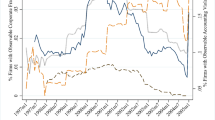Abstract
A principled technique for monitoring the performance of a consumer credit scorecard through time is derived from Kalman filtering. Standard approaches sporadically compare certain characteristics of the new applicants with those predicted from the scorecard. The new approach systematically updates the scorecard combining new applicant information with the previous best estimate. The dynamically updated scorecard is tracked through time and compared to limits calculated by sequential simulation from the baseline scorecard. The observation equation of the Kalman filter is tailored to take the results of fitting local scorecards by logistic regression to batches of new clients that arrive in the current time interval. The states in the Kalman filter represent the true or underlying score for each attribute in the card: the parameters of the logistic regression. Their progress in time is modelled by a random walk and the filter provides the best estimate of the scores using past and present information. We illustrate the technique using a commercial mortgage portfolio and the results indicate significant emerging deficiencies in the baseline scorecard.





Similar content being viewed by others
References
Albert A and Anderson J (1984). On the existence of maximum likelihood estimates in logistic regression models. Biometrika 71: 1–10.
Banasik J, Crook J and Thomas L (1999). Not if but when will borrowers default. J Opl Res Soc 50: 1185–1190.
Banasik J, Crook J and Thomas L (2001). Scoring by usage. J Opl Res Soc 52: 997–1006.
Banasik J, Crook J and Thomas L (2003). Sample selection bias in credit scoring models. J Opl Res Soc 54: 822–832.
Catlin DE (1989). Estimation, Control, and the Discrete Kalman Filter. Springer-Verlag: New York.
Duda RO, Hart PE and Stork DG (2002). Pattern Classification. Wiley Interscience: New York.
Harrison P and Stephens C (1976). Bayesian forecasting. J R Stat Soc B 38: 205–247.
Harvey AC (1990). Forecasting, Structural Time Series Models, and the Kalman Filter. Cambridge University Press: Cambridge.
Hosmer D and Lemeshow S (2000). Applied Logistic Regression. Wiley: New York.
Kalman R (1960). A new approach to linear filtering and prediction problems. J Basic Eng Transac ASME 82: 35–45.
Li H and Hand D (2002). Direct versus indirect credit scoring classifications. J Opl Res Soc 53: 647–654.
Ljung L and Söderström T (1983). Theory and Practice of Recursive Identification. MIT Press: Cambridge, MA.
Lucas A (1992). Updating scorecards: removing the mystique. In: Thomas LC, Crook JN, Edelman DB (Eds). Credit Scoring and Credit Control. Clarendon: Oxford, (1992). 180–197.
Mari C and Reno R (2005). Credit risk analysis of mortgage loans: an application to the Italian market. Eur J Opl Res 163: 83–93.
McCullagh P and Nelder J (1989). Generalized Linear Models. Chapman Hall: London.
McNab H and Wynn A (2000). Principles and Practice of Consumer Credit Risk Management. CIB Publishing: Canterbury.
Meade N (1985). Forecasting using growth curves: an adaptive approach. J Opl Res Soc 36: 1103–1115.
Thomas L, Banasik J and Crook J (2001). Recalibrating scorecards. J Opl Res Soc 52: 981–988.
Thomas L, Edelman D and Crook J (2002). Credit Scoring and its Applications. SIAM: Philadelphia.
Thomas L, Edelman D and Crook J (eds) (2004). Readings in Credit Scoring: Foundations, Developments, and Aims. Oxford University Press: Oxford.
Wagner H (2004). The use of credit scoring in the mortgage industry. J Fin Ser Market 9: 179.
West M and Harrison J (1997). Bayesian Forecasting and Dynamic Models. Springer-Verlag: New York.
Wilkie A (2004). Measures for comparing scoring systems. In: Thomas LC, Crook JN, Edelma DB (Eds). Readings in Credit Scoring. Clarendon: Oxford, (2004). 51–71.
Young PC (1984). Recursive Estimation and Time-Series Analysis: An Introduction. Springer-Verlag: Berlin.
Zhu H, Beling P and Overstreet G (2002). A Bayesian framework for the combination of classifier outputs. J Opl Res Soc 53: 719–727.
Author information
Authors and Affiliations
Corresponding author
Rights and permissions
About this article
Cite this article
Whittaker, J., Whitehead, C. & Somers, M. A dynamic scorecard for monitoring baseline performance with application to tracking a mortgage portfolio. J Oper Res Soc 58, 911–921 (2007). https://doi.org/10.1057/palgrave.jors.2602226
Received:
Accepted:
Published:
Issue Date:
DOI: https://doi.org/10.1057/palgrave.jors.2602226




